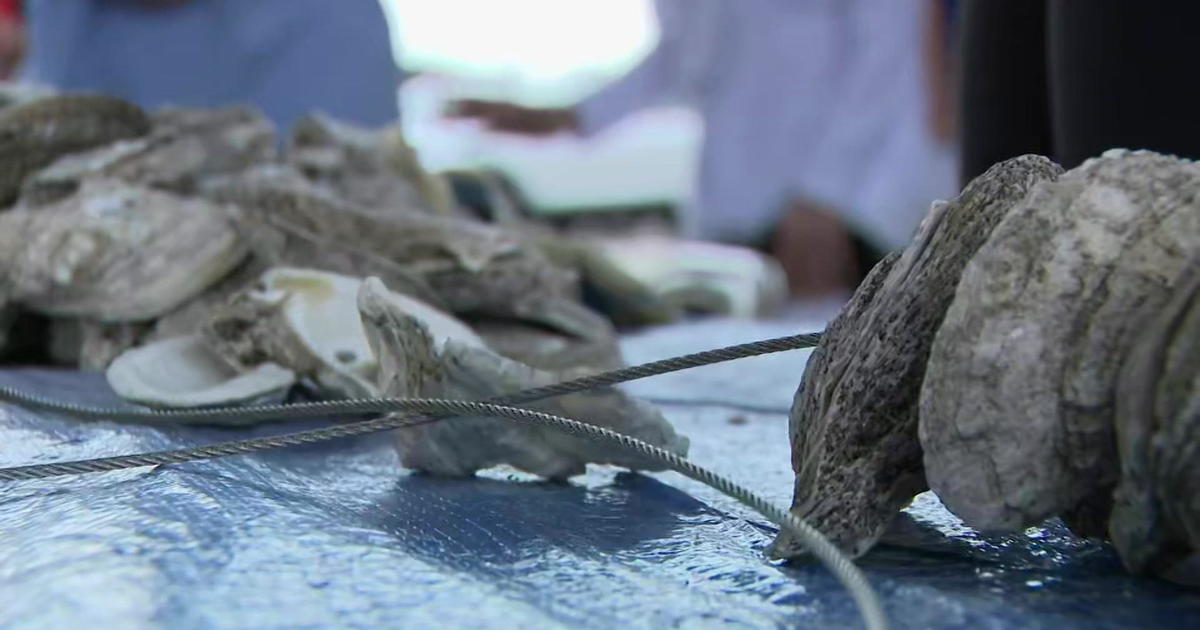The Great Shark Count Off South Florida's Shores
MIAMI (CBS4)- It's a gorgeous winter day in South Florida. Tourist Angelina Gaudino is wading in the water just off the Deerfield Pier.
"It's nice to be in the water in the end of January when my friends in New York are freezing." Gaudino said.
She has no idea she was just swimming with sharks, hundreds of them.
"That's why I don't go all the way out there." She replied when CBS4's David Sutta told her.
From a plane above you can see them. The massive amounts of black dots are presumably black tip sharks. The congregations are all along Palm Beach's shoreline and slowly thins out as you move towards Miami-Dade County.
"It is overwhelming when you first see it. You just can't believe that there are that many sharks." FAU graduate student Shari Tellman said.
Tellman, a shark enthusiast is carrying out research on the massive congregations for FAU. She tells us a majority of the sharks are about four to five feet long. They first started documenting them in 2011, during bi-weekly flights along the Palm Beach coastline.
COUNTING SHARKS
CBS4 first reported on their two year long study last February. Today the study is yielding definitive numbers.
"In the height of February we are looking at 11 to 14,000 per survey. That's a lot of sharks," said Tellman.
How they got to that number is painstaking to watch. During their bi-weekly flights cameras roll and snap. They capture everything from the beach about 200 yards out. It's then Tellman's job to go cross-eyed counting each one.
"You can't do it in one day. You have to stop and you have to go back because it will make you crazy and you will go blind," Tellman said.
Which leads to the question 'Why on earth would anyone do this?'
"We are able to get an idea of their migration patterns and where they are along the shoreline." Tellman explained.
We now know the sharks are snowbirds. They come down here for the warm water. By summer when temperatures have risen up North they are gone.
SHARKS AND RENEWABLE ENERGY
The shark research is also now proving to be instrumental in other work that may be conducted off our shoreline to create renewable energy. Tellman is being funded by FAU's Southeast National Marine Renewable Energy Center.
Program manager Gabriel Alsenas said they are working on cutting edge research on how to extract energy from our ocean.
"If you combine all of the water, of all the fresh water rivers in the world and multiply that by 30, that's how much water is flowing by our shores everyday." Alsenas explained.
But before they drop the first turbine in the ocean they want to know what will be affected.
"If what you end up doing causes more damage than fossil fuels is, for example, to our environment there is no point." he said.
The footage is also documenting rarely captured moments. One shot captured showed hundreds of manta rays moving in a pack. Another image taken feet from the shoreline showed dinner time for a pack a sharks. A quarter of the image looks blacked out but it's actually a wall of bait fish. Within the black wall are white spots - sharks. The fish wisely swimming away.
"If you are looking at swimmers along the beach line and you look at pictures of these sharks, the sharks are right there. These swimmers may or may not know that. But if they did they probably wouldn't be in the water." Tellman said.
MASSIVE SHARKS – MINIMAL ATTACKS
Upon hearing the news of the number of sharks offshore one beachgoer responded "Oh my God. Don't scare me."
Many people near the Deerfield Pier were not aware they could literally throw a rock and hit a shark.
"I can't believe that they can come so close. They can? Really? How many people they bite," one person asked.
Records dating back to 1892 show just 60 attacks in Palm beach and 22 between Broward and Miami-Dade County. None of them were fatal. That changes though as you move North.
"These sharks aren't a threat to humans in clear water. They are following the bait fish and as long as they can tell the difference between a human and bait fish it's okay. When you get up further North where the water is a bit more turbid it's not as easy to tell, "Tellman said.
Gaudino, visiting from New Jersey, said if she comes face to face with a shark she's got a plan.
"I've heard that if you see one you punch him in the nose." she said.
The sharks that we are seeing here in great numbers will likely be gone sometime in March. They are not going to bother you but still it's good advice to take to not swim along the ocean during dawn and dusk. It's when sharks feed.



